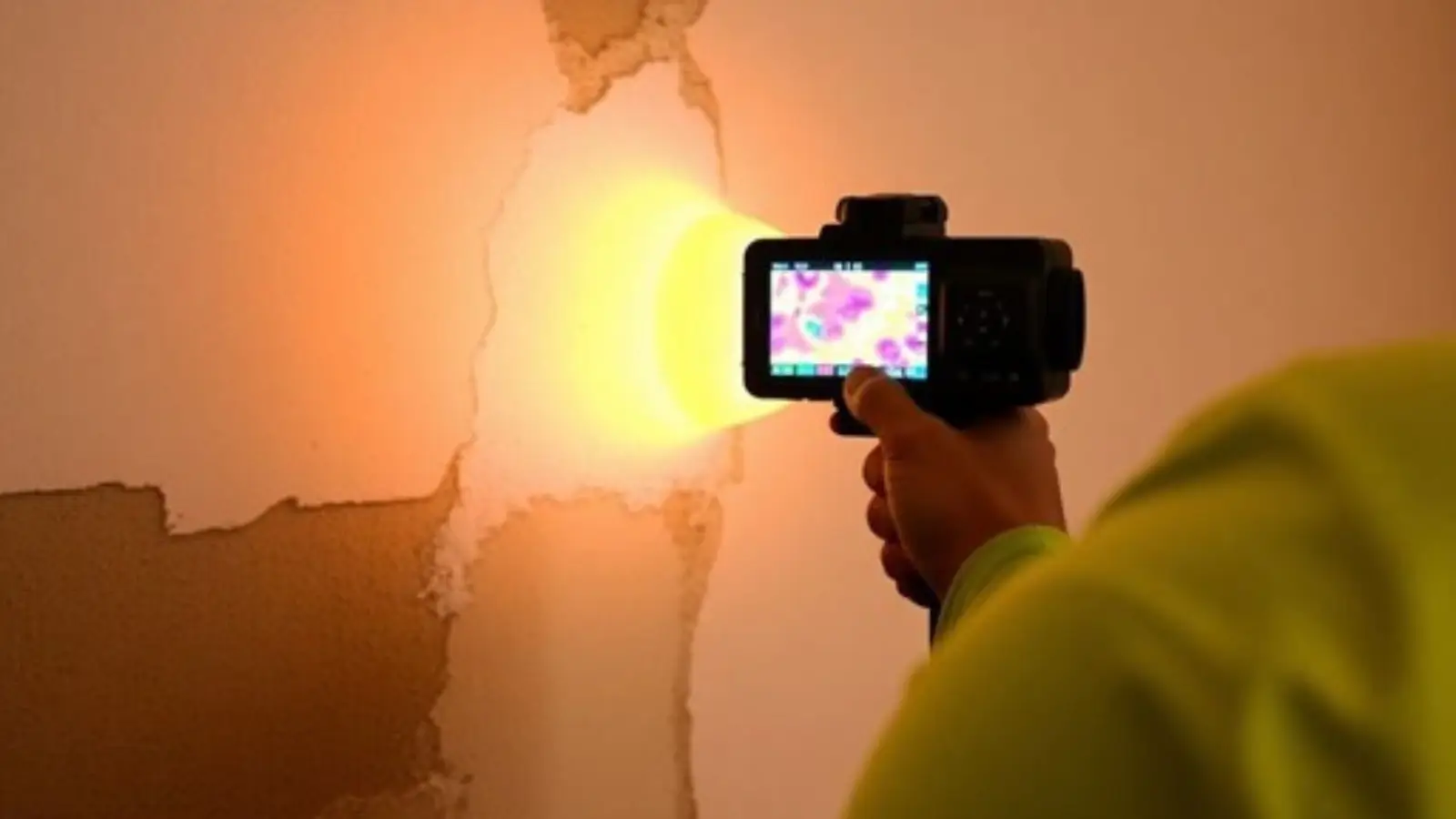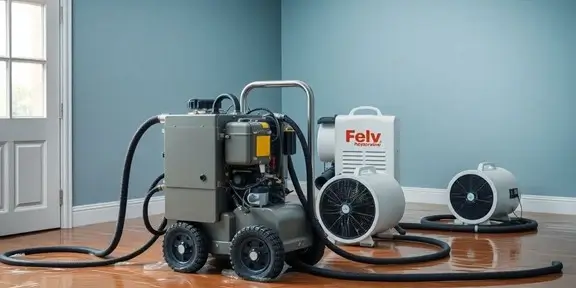


When water damage strikes, finding every last bit of moisture is key. Thermal imaging is a game-changer here. It lets restoration pros see temperature differences on surfaces. This means they can spot damp spots behind walls or under floors that you can’t see with your own eyes. It’s like having X-ray vision for water damage. This advanced detection helps pinpoint the exact source of the problem, stopping it before it gets worse.
Beyond thermal imaging, specialized leak detection systems are also super helpful. These systems use things like sound waves or infrared light to find leaks. They’re really good at pinpointing exactly where water is coming from, even in tiny cracks or pipes. This means less guesswork and less need to tear into walls just to find a leak. It’s all about being precise and efficient.
To get the most accurate picture, restoration teams use moisture meters and hygrometers. Moisture meters measure how much water is actually in materials like wood, drywall, or carpet. This gives a clear number, not just a visual guess. Hygrometers, on the other hand, measure the humidity in the air. Keeping an eye on these readings helps the team know when things are truly dry. This accurate data is vital for a complete restoration and preventing future issues like mold. The use of these tools is a big part of why modern water damage restoration is so much better than it used to be.
Getting water out fast is key. Modern water extraction equipment uses powerful pumps and vacuums to remove standing water quickly. This advanced tech means less time spent dealing with the mess and a lower chance of secondary damage like mold. These machines are built for tough jobs, handling everything from small leaks to major floods.
Once the bulk of the water is gone, the real drying begins. Industrial-grade dehumidifiers pull moisture right out of the air, while high-speed air movers circulate that drier air across wet surfaces. This combination speeds up evaporation significantly. Think of it as creating the perfect environment for drying. Using these tools helps prevent mold and keeps materials from warping.
Technology has really changed how fast we can dry out a property. Specialized dehumidifiers, like LGR units, are super efficient, even in cooler or less humid conditions. They pull more water from the air than standard models. Paired with powerful air movers that push air exactly where it's needed, the drying process is much faster. This means getting back to normal sooner and avoiding long-term issues from water damage. The goal is always to speed up the drying process as much as possible.

Water damage restoration projects can get complicated fast. Keeping track of everything, from the initial assessment to the final drying report, is a big job. That's where modern project management tools really shine, making the whole process smoother and more organized. These tools help restoration companies manage jobs more effectively.
Think of job tracking software as the central hub for your restoration project. It lets technicians log every step, upload photos of the damage and repairs, and record drying readings. This detailed record-keeping is super important for transparency with clients and insurance adjusters. It means everyone is on the same page about what's happening and why. This kind of organized approach minimizes confusion and speeds up approvals.
When a water damage event happens, time is critical. Mobile apps connect the field team directly to the office and clients. They allow for instant updates, photo sharing, and status checks right from a smartphone or tablet. This real-time communication means faster decision-making and quicker progress on the job. It really helps keep the project moving forward without delays.
Good documentation is key in water damage restoration. Project management tools make it easy to create thorough records of the entire process. This includes everything from initial moisture readings to the final dehumidifier reports. Having this clear documentation builds trust with clients and makes the insurance claims process much simpler. It shows exactly what was done and why, making the restoration process more understandable for everyone involved.
Modern restoration efforts are increasingly focused on using equipment that's not only powerful but also kind to the planet and your wallet. This means employing tools that consume less energy while still getting the job done effectively. Think advanced dehumidifiers and air movers that work smarter, not harder. This shift towards energy-efficient restoration equipment helps reduce operational costs and environmental impact.
Beyond just drying, preventing future problems is key. Advanced mold prevention technologies are now standard practice. This includes using HEPA air scrubbers to clean the air of microscopic mold spores and applying specialized antimicrobial coatings to surfaces that are prone to mold growth. These treatments create a barrier, stopping mold before it can even start.
After the water is gone and the drying is complete, the focus shifts to making sure the air inside is clean and healthy. This involves thorough cleaning and often the use of air purification systems. The goal is to remove any lingering contaminants or allergens, ensuring a safe environment for occupants. It's a critical step in the overall restoration process, making sure the property is truly restored to its pre-damage condition.
Robots are changing how we look at water damage. Small, camera-equipped robots can get into tight spots that people can't easily reach. This means we can get a good look at damage under floors or in wall cavities without having to tear everything apart. These robots collect important data, helping us figure out the best way to fix things. Using robotics for assessment means less disruption and a more accurate picture of the problem.
Once the cleanup starts, remote monitoring keeps everyone in the loop. We can track how the drying process is going without needing to be physically present all the time. This allows for quick adjustments if needed and keeps the project moving forward efficiently. It’s a way to watch over the restoration work from afar, making sure everything stays on track.
Advanced inspection techniques, including those using robotics, are key to minimizing how much your daily life is interrupted. By using these tools, restoration teams can pinpoint the exact areas needing attention. This targeted approach means less guesswork and faster, more effective repairs. The goal is always to get your property back to normal with as little hassle as possible, and advanced inspection methods are a big part of that.
Artificial intelligence is changing how water damage restoration works. It helps teams figure out where damage is and how bad it is, often before humans can even see it. This means faster, smarter fixes.
AI can look at weather patterns, building history, and even sensor data to guess where water damage might happen next. This lets companies get ahead of problems. Think of it like a weather forecast, but for your property's water risks. This predictive power is a big deal for preventing damage before it starts.
Once damage occurs, AI can help plan the best way to fix it. It looks at all the information – the type of water, how much there is, what materials are affected – and suggests the most efficient steps. This means using the right equipment and techniques for the job, cutting down on time and cost. Using AI in restoration means a more organized and effective cleanup.
AI systems can also track ongoing restoration projects. They analyze data from the job to see if things are on track and if any risks are popping up. This helps managers make quick decisions to keep the project moving smoothly and safely. The goal is to reduce any potential problems and make sure the restoration is done right the first time. This data analysis is key to good risk management.
When water damage strikes, time is of the essence. Choosing a 24/7 water damage restoration company means you get immediate attention, which is vital for minimizing the extent of the damage. Waiting even a few hours can lead to more significant structural issues and the potential for mold growth. A company that operates around the clock is prepared to handle emergencies whenever they occur, offering peace of mind.
Property owners can't always predict when a pipe will burst or a storm will hit. Having access to a 24/7 water damage restoration service ensures that professionals can begin the mitigation process right away. This rapid response is key to preventing water from spreading further into building materials, which can save on repair costs and reduce the overall restoration time. The ability to act quickly is what separates minor inconveniences from major disasters.
Emergencies don't keep business hours, and neither should your restoration team. A 24/7 water damage restoration company provides continuous availability, meaning help is just a phone call away, day or night, weekend or holiday. This constant readiness means that your property receives the attention it needs precisely when it needs it, preventing secondary damage like mold and structural weakening that can occur if water sits for too long.
Beyond just being available, a reputable 24/7 water damage restoration company brings modern restoration techniques to your doorstep. They are equipped with the latest technology for water extraction, drying, and dehumidification, significantly speeding up the recovery process. Their teams are trained in advanced methods to accurately detect hidden moisture and treat affected areas effectively, ensuring a thorough and lasting restoration. Relying on their expertise means your property is handled with the best possible care.
So, it's pretty clear that technology has really changed the game when it comes to fixing water damage. Things that used to take ages, like finding hidden leaks or drying out a whole house, can now be done much faster and more accurately. Tools like infrared cameras and advanced moisture meters help professionals pinpoint problems without tearing everything apart. Plus, better drying equipment means less time waiting around for things to dry out, which is a huge relief for anyone dealing with a flood. It’s good to know that the industry is moving forward, using these new tools to make a stressful situation a little bit easier and quicker to get through.